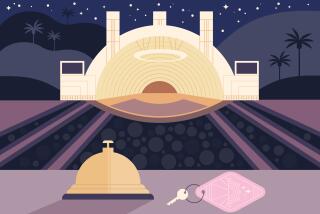Gehry’s hotel sparkles in Rioja Alavesa
- Share via
Elciego, Spain — The theatrical, floor-to-ceiling, merlot-colored drapes at the Marqués de Riscal would suit a production of “Hedda Gabler” or “Hamlet.”
But this is not a tragedy.
This is a guest room at the first and only hotel designed by Frank Gehry. When the curtains part at the push of a button, you see a picture window with angular contours, erratically tilted panes and a zigzagging window seat. The undercarriage of the roof, wrapped in pink, gold and silver titanium ribbons, is visible in the foreground and in the distance lies the sleepy stone village of Elciego, surrounded by soldierly vineyards of northern Spain’s Rioja wine country.
In February, my sister Martha and I spent two sybaritic nights at the Hotel Marqués de Riscal, about 75 miles south of the Basque port city of Bilbao, where we toured Gehry’s iconoclastic Guggenheim Museum, now a decade old but no less arresting for its age. In Bilbao, we ran our palms across its smooth titanium panels, crossed its catwalks and looked at the rejuvenated Bilbao riverfront from its canopied terrace. In a gallery the size of a football field, we wandered around a collection of works by Richard Serra, admiring the way the building and the artist’s enormous steel-plate sculptures worked together.
We could have stayed all afternoon, but we didn’t mind having to leave because we were headed to a newer landmark where we were going to sleep, eat, drink and have spa treatments under another roof that Gehry built.
The hotel was conceived as the château in Rioja Alavesa, a grape-growing region that has become almost as sophisticated as the Napa Valley and is dotted with wineries designed by such avant-garde architects as Zaha Hadid and Santiago Calatrava. The Riscal took four years to complete, partly because Gehry’s Los Angeles-based architectural firm had to develop special methods for working with colored titanium and because the winery decided after the design process started to turn the building into a 43-room hotel.
‘A marvelous creature’
“When first approached about the project, Frank was a bit hesitant to take it on,” said Andy Liu, a Gehry Partners associate who was the project architect for the hotel. “Logistically, Bilbao is not the easiest place to reach, and Elciego even less so.... Nevertheless, he was coaxed into visiting the site and once the mission for the project — to build a château for the 21st century — became clear, he agreed. The vintage bottle of wine from 1929 [his birth year] that they uncorked during his visit certainly didn’t hurt.”
Riojas, made mostly from the region’s red tempranillo grapes, are almost always beneficial, I think. I started sampling them even before checking into the hotel, over lunch at the restaurant in the Guggenheim Bilbao. Which might have been why I missed the highway turnoff for Elciego and ended up taking the back way to the Marqués de Riscal complex through rolling fields of grape vines.
When we crested a hill, we suddenly saw the shiny ribbons of titanium — mined in Russia and Australia — draped around the roof of the hotel. Like the Guggenheim Bilbao and the Walt Disney Concert Hall in L.A., this quasi-sculptural Gehry creation could cause car crashes. It looks more like a preliminary, freehand sketch than a finished building, and it made us laugh. Gehry’s buildings are like that.
As the architect has said, “It’s a marvelous creature, with hair flying everywhere.”
The hotel is on a hill overlooking the Marqués de Riscal winery complex, designed in 1858 by Ricardo Bellsola. The architect was sent to France to seek inspiration from the châteaux of Bordeaux. When he got back he created a symmetrical stone ensemble in the then avant-garde, neoclassical style. Now the old bodega buildings and wild-haired creature looming above it are a vivid commentary on where Western architecture came from and where it’s going.
I had read several mixed reviews after the hotel opened (it is managed by the Starwood Luxury Collection). They faulted the food and service, but Martha and I were almost embarrassed by the commotion our arrival caused (even though no one knew I was a travel writer). The service was excellent throughout our stay.
We had booked a $520 room without specifying whether we wanted to stay in the phantasmagoric main building or the more traditional, box-like annex. The two, connected by a bridge, are strikingly different — the first, pure Gehry amazement and fun; the second, utilitarian and unsurprising, housing the pool and spa on the ground floor.
A bellman showed us rooms in both buildings. The room in the annex was large, with a vineyard view and cool orange chaise by contemporary furniture designer Ligne Roset. But there was no contest when we saw a room on the second floor of the main building, with its dramatic picture window. (Later, I got a peek at the main building’s Gehry Suite, which has a private terrace and perfectly framed view of Elciego’s Spanish Gothic San Andrés Church.)
No. 10 at the Marqués de Riscal was so unlike the normal hotel room that it made us slightly giddy. You enter by a long hallway. The wall panels are made of pale, raw maple that also lines the floor, bare except for a simple area rug. A king bed with a prow-like leather headboard designed by Gehry dominates the room. The architect also designed the cloud lamps on the bedside tables, made of seamed white fabric balloons, and chose the green and black marble in the bath on the far side of the room.
There are, of course, all the requisite gadgets, including a high-definition, self-adjusting Bang & Olufsen TV, Wi-Fi access and phones that work by using a broadband connection. But the last thing we wanted to do was to watch CNN or surf the Internet when we could lie in bed and watch the sun set over the vineyards, turning the titanium into jewelry.
At cocktail hour, we wandered down to the ground-floor wine bar, a pie-shaped space with a lofty ceiling, where we sat in orange Ligne Roset chairs by the window, which offered the same church view as the Gehry Suite. The wine bottles were stored in floor-to-ceiling cubbyholes, so the bartender had to climb a ladder to reach our Marqués de Riscal 2001 Gran Reserva. It was soft, rich and delicious. With it we sampled croquetas, fried morsels of creamy cheese and ham that are ubiquitous in Rioja Alavesa.
Northern Spain has lately emerged on the gastronomical scene, anchored by El Bulli, north of Barcelona, which some consider the best restaurant in the world. But the Basque region has its fair share of acclaimed eateries, including Echaurren, the domain of Francis Paniego, the first Riojan chef to win a Michelin star. He is also a consultant for the restaurant at the Marqués de Riscal.
We loved the buffet breakfasts, especially the Burgos cheese and ham, in the airy, third-floor 1860 Restaurant, where madcap building sketches by Gehry decorate the walls. But the fare in the more formal dining room across the hall didn’t impress us: The first night, we had lovely, pickled white asparagus and reasonably tasty bean and chorizo sausage stew, two local specialties it’s hard to go wrong with anywhere in Rioja Alavesa. The next evening, my fried hake and Martha’s fresh cod struck us both as bland.
That assessment was supported by our lunch at La Posada Mayor de Migueloa in nearby Laguardia, a charming medieval town crowded with bodegas, each selling its own homemade Rioja. The red table wine that accompanied our meal at the dignified, old-fashioned posada wasn’t as good as what we had been drinking at the Marqués de Riscal, but I will remember the veal-stuffed chile peppers in tomato sauce.
That was our only excursion away from the hotel, where we also booked treatments at the spa, operated by Caudalie. The company, which has headquarters in Bordeaux, uses a patented grape-seed formula for its skin-care products and cosmetics. I tried the spa’s two-hour introductory program, starting with a bath in red-grape extract, followed by a warm bentonite clay wrap and a massage.
I felt like a brand-new woman until I entered the dressing room afterward. There I found a photo crew from Elle magazine taking pictures of a tall, svelte model in nothing but high heels and bikini underpants. She needed no bentonite clay to make her look beautiful.
But the best part of the whole adventure was lying in bed in the morning with a cup of cappuccino, looking out Gehry’s titanium-framed window. Martha and I talked about books, architecture and our late mother, who was right about almost everything. She was widely traveled but no hotel aficionado and always said it didn’t matter where you stayed in interesting places like Rioja Alavesa because you weren’t likely to spend much time in the room. Boy, did she get that one wrong.
susan.spano@latimes.com
More to Read
Sign up for The Wild
We’ll help you find the best places to hike, bike and run, as well as the perfect silent spots for meditation and yoga.
You may occasionally receive promotional content from the Los Angeles Times.






